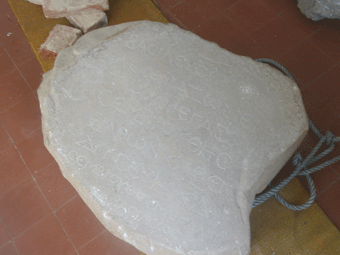Archeological findings call for a revision of history
.
By: Samuel Kahsay
Eritrea is blessed
with unique and marvelous archeological sites of national, regional and
global significances. So far about 40,000 archeological sites have been
identified, with more sites yet to be excavated in the course of time.
Solid and compelling evidences of artifacts so far discovered at limited
sites, nevertheless, indicate the existence of ancient civilizations in
the Eritrean highlands prior to 800 BC (this was the period associated
with the rise of the Axumite civilization).
 |
These excavations
eventually contradict inaccurate views previously held by the world and
counterbalance imprecise historical facts, which argue that the Axumite
civilization had been the core of ancient civilization in the Horn of
Africa.
Evidences with regards to the existence of a more civilized and
centralized civilization in the Eritrean highlands even before the
foundation of the Axumite Kingdom have also been attributed to these new
archeological findings.
The archeological site found in Dembezan,
Dekemhare can be taken as solid evidence in highlighting the role of the
region in the leadership of the Axumite kingdom. The stone that was
collected by the Italian government during the Italian colonial period has
inscriptions in Greek and Amharic, dedicated in the memory of King
Sambrutes of Axum in the 2nd century AD. The most fascinating thing is
that the king came to the village of Dembezan to celebrate the 24th
anniversary of his reign. The first question that comes to one’s mind is
why the king chose to celebrate his anniversary in one of the villages in
the highlands. Administrator and Cultural Resource Manager in the National
Museum of Eritrea, Mr. Rezene Russom, said that this monument could prove
that Eritreans were also participating in the affairs of the Axumite royal
family, because only the royal clan had access to power at that time.
”This stone is a documented evidence because all the information was
inscribed on it in Greek and Amharic,” he said “ the power of kingship at
that time was not simply confined to Tigrayans, but Eritreans from the
highlands as well.“ He further said that chances are the King’s roots can
be found in Dembezan, which gives more meaning to the fact that he chose
to celebrate his anniversary in a village on the Eritrean
highlands.
The findings of other recent scientific excavations also
contradict the dominant historical paradigms that have prevailed in this
region for the last 300 years. Excavations of the sites in the Great
Asmara region-in Maitemenay in 1995 by Dr. Yosief Libeseqal and the Sembel
sites by Dr. Peter Schmidt in 1998-99, and other sites in the greater
Asmara by Matt Curtis testify to the rise of indigenous complex societies
in 800-400 BC in the Eritrean highlands. Mr. Daniel Habtemichael, lecturer
in the Department of Archeology and Anthropology at the University of
Asmara in a thesis paper he presented for his masters degree program
wrote,” the date of this finding overlaps with the time of the alleged
Sabaean immigration, thus disproving or at least questioning these ‘taken
for granted’ hypotheses.”
Moreover, archeological findings in
Maitemenay in the year 1997 produced historical relics dating back to 400
BC, which is 600 years before the foundation of Axum. The joint research
undertaken by the Department of Archeology at the University of Asmara,
and their colleagues at the University of Florida in 1998 also revealed
that the “precursors of urbanism” in Eritrea were indigenous, and older
than the well-publicized legacies of the Axumite Empire.
Mr.
Daniel said, “the taken for granted theories about the first millennium BC
are insufficient and not strong enough to withstand the challenge of the
recent research around the Great Asmara area and other sites.” In his
survey in the valley of Keskese, Daniel questions the long held claims of
the Sabaean influence and the dominant historical paradigms. “Giving the
rise of early Pre-Aksumite communities in the Eritrean highlands, there is
a need for further research to explain what regional relationships may
have existed during this period on either side of the Red Sea,” he said.
Professor Peter R. Schmidt in his discoveries also came up with
findings that change the way the rise of urbanism is seen in the horn of
Africa. In his research in the Great Asmara area, Professor Peter argues
that the communities around today’s Asmara were the first in the region to
show an organic growth toward demographic complexity. He concluded his
research paper by saying,“ the ceramics of the Ona culture suggests that
the communities around Asmara were indigenous. There is currently no
evidence that the Ona communities were influenced by Sabean incursions to
the south or that they were an integral part of the Ethio-Sabean cultural
complex.” Similar research works have also revealed the development of an
indigenous culture without any major outside influence.
Needless
to say, intensive scientific research should be pushed forward to change
the history of the region and revise the dominant historical paradigm that
existed for the last 300 years. Therefore, comprehensive and extraordinary
archealogical discoveries are critical to convince the world, and to
maintain our national identity as well as the history of our ancient
civilization.